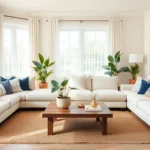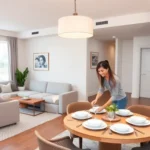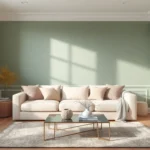We’ve all experienced that awkward moment when guests walk straight from our front door into the heart of our living space. Without a proper entryway transition, homes can feel cramped and lack the welcoming atmosphere we’re trying to create. The good news? You don’t need a traditional foyer to establish a stunning entrance that sets the tone for your entire home.
Creating a defined entryway within your living room isn’t just about aesthetics – it’s about functionality and flow. Whether you’re working with a small apartment or an open-concept home, strategic design choices can transform that immediate entry area into a stylish and practical space that guests will remember.
We’ll show you how to maximize your living room’s potential with clever entryway answers that work for any budget or space constraint. From room dividers and furniture placement to lighting tricks and storage answers, these ideas will help you create the perfect first impression while maintaining your living room’s comfort and style.
Create a Welcoming First Impression With Statement Lighting
Lighting transforms any living room entryway from ordinary to extraordinary while setting the mood for your entire home. Strategic illumination creates visual boundaries that naturally define your entrance space without requiring permanent structural changes.
Pendant Lights for Modern Appeal
Pendant lights offer sleek sophistication that instantly elevates your living room entryway design. We recommend installing single statement pendants 7-8 feet above the floor to create dramatic focal points without overwhelming smaller spaces.
Geometric shapes like hexagons, cylinders, and spheres work exceptionally well in contemporary homes, while natural materials such as rattan, wood, and woven fibers add organic warmth. Position these fixtures directly above console tables or benches to create cohesive lighting zones that guide guests naturally into your living space.
Installation tip: Choose adjustable-height pendants that allow you to customize the positioning based on your ceiling height and furniture arrangement.
Chandelier Options for Elegant Entryways
Chandeliers bring luxurious ambiance to living room entryways while serving as stunning architectural elements. We suggest selecting fixtures that measure 20-24 inches in diameter for standard 8-foot ceilings, scaling up proportionally for higher spaces.
Crystal chandeliers create sparkling light patterns that make small entryways feel more spacious and grand. Modern linear chandeliers work beautifully over narrow console tables, while rustic wrought iron designs complement farmhouse and transitional decorating styles.
Size considerations matter significantly: measure your entryway width and subtract 2 feet to determine the maximum chandelier diameter that won’t overwhelm the space.
Table Lamps for Warm Ambient Lighting
Table lamps provide flexible lighting answers that create cozy, welcoming atmospheres in living room entryways. We place pairs of matching lamps on console tables or single statement pieces on round accent tables to establish balanced illumination.
Ceramic bases in neutral colors like white, cream, and soft gray complement any decorating style, while brass and copper finishes add sophisticated metallic accents. Fabric lampshades diffuse light beautifully, creating soft pools of warmth that make guests feel instantly comfortable.
Practical benefits include easy repositioning for seasonal decorating changes and the ability to adjust lighting levels using dimmer switches or smart bulbs for different times of day.
Define Your Space With Strategic Furniture Placement

Smart furniture placement creates clear boundaries between your entryway and living space while maximizing functionality. We’ll explore three key furniture answers that help establish your entrance zone without overwhelming your room.
Console Tables as Functional Focal Points
Console tables serve as the perfect centerpiece for defining your living room entryway space. We recommend positioning these versatile pieces directly inside your entrance to create an immediate visual boundary between zones. Their surface provides an ideal landing spot for keys, mail, and daily essentials that tend to accumulate near doorways.
Storage opportunities multiply when you choose console tables with drawers or lower shelves. We’ve found that these functional elements help maintain organization while keeping your entryway clutter free. Decorative items like lamps, plants, or artwork can transform the console surface into an attractive focal point that welcomes guests.
Width considerations matter when selecting your console table to ensure proper flow through the space. We suggest measuring your entryway area carefully to choose a piece that defines the zone without creating traffic bottlenecks.
Bench Seating for Practical Storage
Bench seating transforms your living room entryway into a practical changing station for shoes and outerwear. We love incorporating benches or ottomans because they provide comfortable seating while offering hidden storage compartments for seasonal items, bags, and footwear.
Positioning your bench perpendicular to the entrance creates a natural stopping point that encourages guests to pause and transition into your home. We recommend choosing upholstered options that complement your living room furniture to maintain visual continuity throughout the space.
Dual functionality makes benches incredibly valuable in smaller homes where every piece must work harder. We’ve seen homeowners successfully use storage benches to house everything from winter boots to pet supplies while maintaining an organized appearance.
Floating Shelves to Maximize Floor Space
Floating shelves create vertical storage answers that keep your floor space open and uncluttered. We install these space saving elements at eye level to display decorative objects, books, or practical items like baskets for keys and sunglasses.
Wall mounted storage eliminates the bulky footprint of traditional furniture while maintaining the storage capacity you need. We recommend grouping shelves in odd numbers or asymmetrical arrangements to create visual interest without overwhelming your entryway design.
Customization options allow you to tailor floating shelves to your exact needs and aesthetic preferences. We suggest coordinating shelf materials with existing furniture finishes to create a cohesive look that ties your entryway seamlessly into your living room decor.
Add Visual Interest Through Color and Pattern
Transforming your living room entryway becomes effortless when we embrace the power of color and pattern to create visual impact. Strategic design choices help establish a cohesive flow between your entrance and living space.
Accent Walls to Create Depth
Focal wall placement instantly transforms your entry area into a defined space that welcomes guests with personality. We recommend selecting the wall that guests see first upon entering, then applying bold colors or striking patterns to create an immediate visual anchor point.
Textured elements enhance the dimensional quality of your accent wall through natural materials and varied surfaces. Consider incorporating woven baskets mounted as wall art, reclaimed wood panels, or stone veneer to add tactile interest that complements your color scheme.
Strategic color selection ensures your accent wall enhances rather than overwhelms the entire living space. Choose colors that appear in your existing furniture or artwork, creating a natural bridge between the entryway and main living area.
Bold Rugs to Anchor the Entry Area
Statement rugs define your entryway boundaries while providing a warm, welcoming foundation for guests as they transition into your home. Position a vibrant, eye-catching rug directly inside the entrance to create an instant sense of arrival and purpose.
Two-tone tiles offer a durable flooring alternative that delivers both style and practicality for high-traffic entry areas. Select contrasting tile colors in geometric patterns to create visual movement while maintaining easy maintenance for muddy shoes and wet weather.
Size considerations play a crucial role in rug selection for entry areas that flow into living spaces. Ensure your rug extends at least 18 inches beyond your entry furniture to create proper visual balance and prevent the space from feeling cramped.
Coordinated Throw Pillows for Cohesive Design
Unified color schemes connect your entryway seating with your main living room furniture through carefully selected throw pillow combinations. We suggest choosing pillows that share at least one color with your accent wall or statement rug to maintain visual harmony throughout the space.
Patterned throws add layers of visual interest while tying together different design elements across your open floor plan. Mix geometric patterns with organic shapes, ensuring each pattern shares a common color thread to prevent visual chaos.
Texture variation creates depth and sophistication when combining throw pillows across your entryway and living areas. Pair smooth velvet pillows with chunky knit textures, or combine linen weaves with faux fur accents to add tactile appeal that invites touch and comfort.
Incorporate Smart Storage Solutions
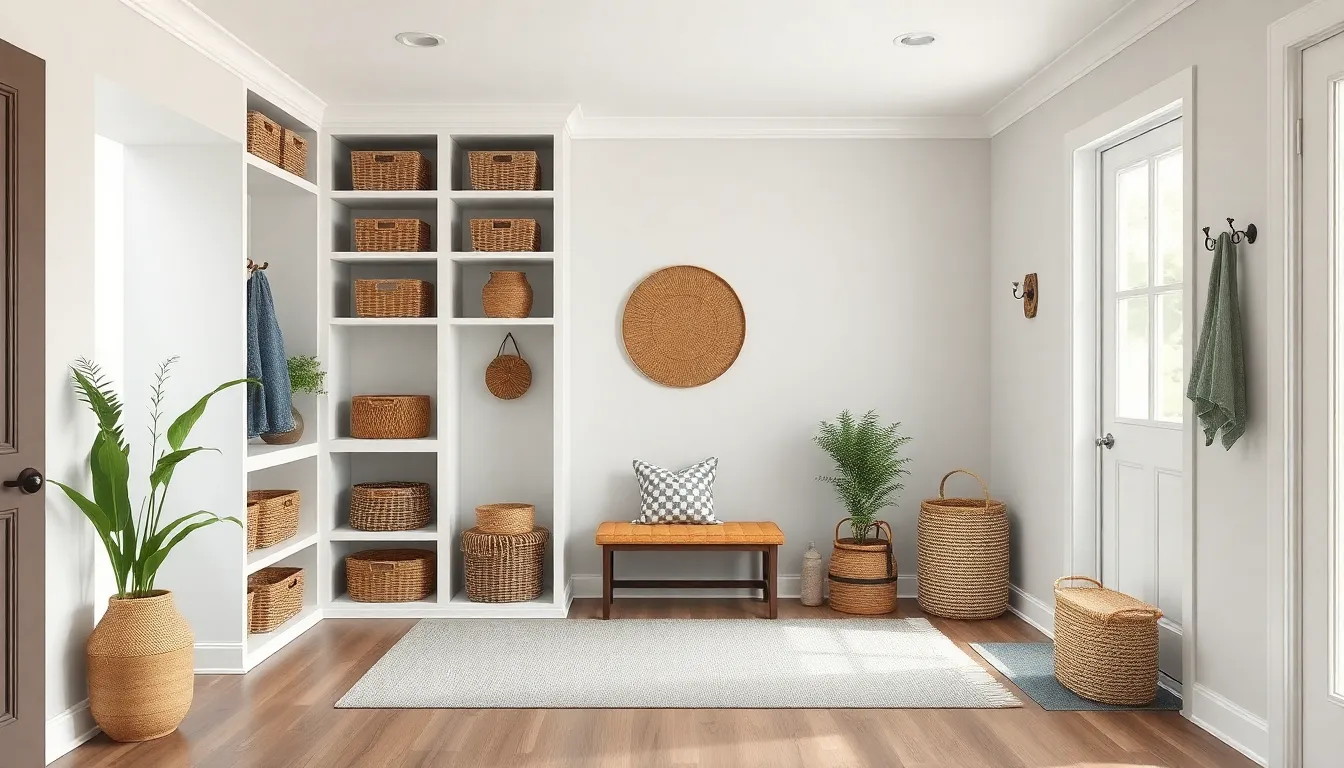
Storage answers transform cluttered entryways into organized, functional spaces that welcome guests while keeping essentials within reach. Smart storage options maximize every inch of your living room entryway without sacrificing style.
Built-In Cubbies for Organization
Built-in cubbies offer customized storage that seamlessly integrates with your entryway design. These compartments can be customized to fit your exact needs, whether you require space for keys, sunglasses, or daily essentials. Installing cubbies at different heights accommodates various family members and creates visual interest on your walls.
Customization options allow you to designate exact spaces for different items, ensuring everything has its place. We recommend incorporating labels or small dividers within larger cubbies to maintain organization over time. Built-in answers also add permanent value to your home while eliminating the need for additional furniture pieces.
Decorative Baskets for Hidden Storage
Wicker baskets combine functionality with natural texture, making them perfect for concealing seasonal items like flip-flops or winter accessories. These versatile containers can store everything from scarves and gloves to umbrellas and pet supplies while maintaining an attractive appearance.
Decorative trays placed near your entrance provide designated spots for keys and small items while adding stylish elements to your design. Multiple basket sizes allow you to create layered storage answers that accommodate different types of belongings. We suggest choosing baskets that complement your existing color scheme to maintain visual harmony throughout the space.
Storage baskets positioned on lower shelves or floor level work particularly well for items you access frequently. Their portability means you can easily relocate them for cleaning or seasonal reorganization.
Wall-Mounted Hooks for Easy Access
Wall-mounted hooks provide immediate access to coats, bags, and frequently used items while keeping your entryway floor clear. Installing hooks at varying heights accommodates different family members and creates an organized system for daily essentials.
Combining hooks with floating shelves or baskets above them maximizes your vertical storage potential while maintaining style. This layered approach allows you to display decorative items on shelves while keeping functional items on hooks below. We recommend spacing hooks adequately to prevent overcrowding and ensure each item has sufficient room.
Strategic placement ensures hooks remain functional without overwhelming your entryway design. Consider installing multiple hook systems at different levels to create zones for different types of items, such as everyday coats versus seasonal outerwear.
Enhance the Atmosphere With Decorative Elements
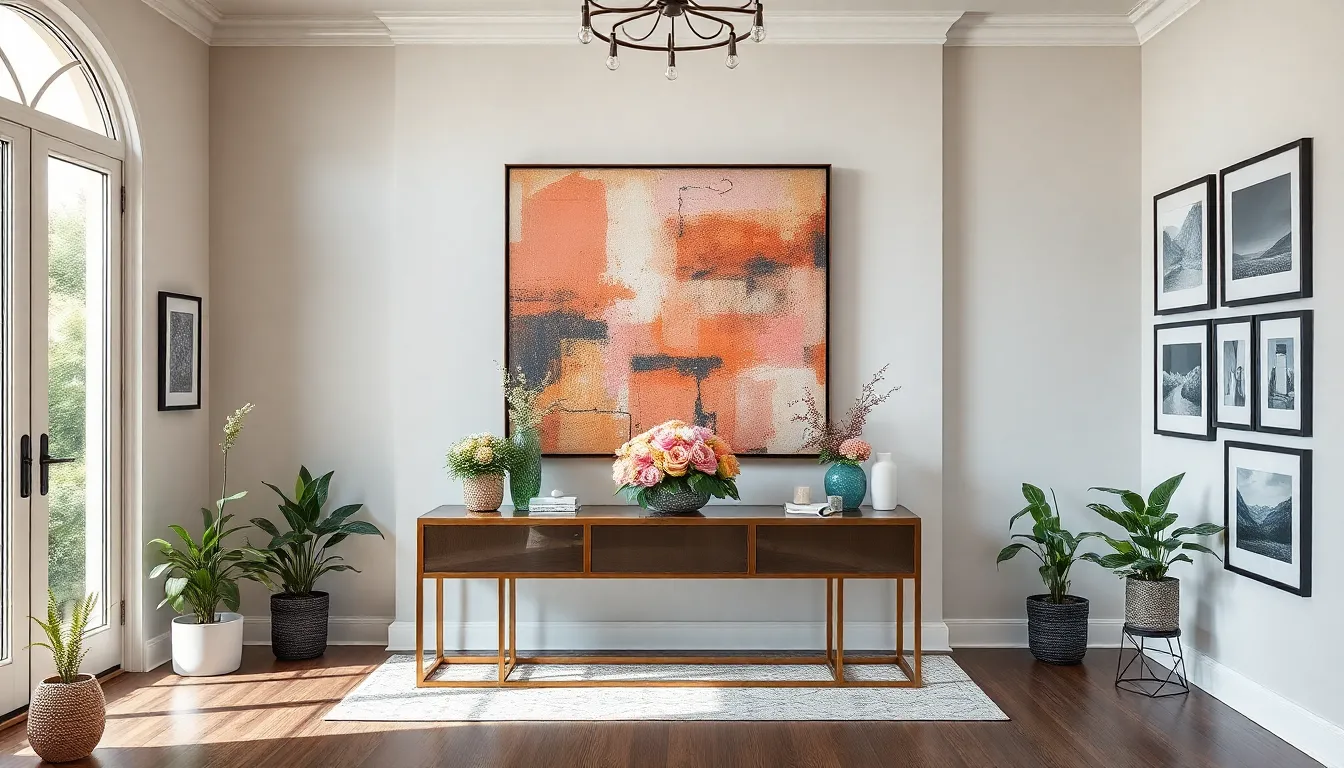
We’ll transform your living room entryway with carefully chosen decorative elements that create lasting impressions. These finishing touches add personality while maintaining the functional foundation we’ve already established.
Artwork and Mirrors to Reflect Style
Large scale art pieces serve as instant style setters for your entire home. Position statement artwork directly across from the entrance to create an immediate focal point that guests notice upon arrival. Gallery walls work exceptionally well in entryways with higher ceilings, allowing you to showcase multiple pieces that tell your story.
Mirrors strategically placed reflect natural light and create the illusion of expanded space throughout your entryway. Oversized mirrors positioned opposite windows maximize daylight reflection, making smaller entryways feel more spacious and welcoming. Round mirrors soften angular furniture lines, while rectangular options complement console tables and built-in storage answers we discussed earlier.
Coordinated frames tie your artwork collection together without requiring identical pieces. Mix different sized frames in matching finishes to create visual cohesion while maintaining individual character in each piece.
Plants and Greenery for Natural Appeal
Indoor plants bring life and warmth to your living room entryway space. Tall floor plants like fiddle leaf figs or snake plants fill vertical corners without cluttering walkways, while smaller potted varieties work perfectly on console tables alongside your keys and mail storage.
Fresh flower arrangements create an instantly welcoming atmosphere that changes with your mood and seasons. Weekly bouquets in coordinating vases maintain that fresh, lived-in feeling while complementing your established color palette.
Low maintenance options ensure your greenery stays beautiful without constant attention. Succulents, pothos, and ZZ plants thrive in various lighting conditions while adding natural texture to your carefully curated entryway design.
Seasonal Decor for Year-Round Interest
Holiday themed accents keep your entryway feeling fresh and current throughout the year. Switch out throw pillow covers, small decorative objects, and artwork to reflect different seasons without overwhelming your established design foundation.
Seasonal flowers provide natural transitions between months while maintaining your entryway’s welcoming appeal. Spring tulips, summer sunflowers, autumn branches, and winter evergreens each bring unique textures and colors to complement your existing decor.
Flexible decorative elements allow easy updates without major redesigns. Interchangeable items like candles, small sculptures, and seasonal books let you refresh your space while keeping the core furniture and storage answers we’ve implemented intact.
Maximize Small Spaces With Multi-Functional Design

Creating a functional living room entryway requires smart design choices that serve multiple purposes simultaneously. We’ll explore strategic answers that transform compact spaces into organized, welcoming entrances.
Vertical Storage Answers
Floor to ceiling cabinets maximize storage capacity without consuming valuable floor space. These slim installations accommodate coats, umbrellas, and seasonal accessories while maintaining visual openness in your entryway area.
Wall mounted shelves provide accessible storage for daily essentials like keys, mail, and decorative items. Installing these shelves at varying heights creates visual interest while keeping frequently used items within easy reach.
Hanging organizers transform unused door space into functional storage areas. Position these organizers on the back of your front door or nearby closet doors to store small accessories, gloves, or cleaning supplies without cluttering main walkways.
Dual-Purpose Furniture Pieces
Storage ottomans serve as comfortable seating while concealing shoes, bags, and other entryway necessities. These versatile pieces can be easily moved when you need additional seating for guests or repositioned to accommodate changing seasonal storage needs.
Console tables with built in storage compartments create a designated landing spot for keys and mail while housing items you’d prefer to keep hidden. Choose consoles with drawers or cabinets to maintain a clean, organized appearance in your living room entrance.
Benches featuring under seat storage provide comfortable transition seating for putting on or removing shoes. These functional pieces offer hidden compartments for storing seasonal footwear, umbrellas, or bags that would otherwise create visual clutter.
Space-Saving Organization Tips
Hooks and racks positioned at strategic heights accommodate different family members while keeping coats, bags, and hats easily accessible. Install multiple hooks at varying levels to maximize vertical wall space without overwhelming the entrance area.
Trays and baskets placed near your entrance collect daily items like keys, sunglasses, or mail that need immediate organization. These portable containers can be easily moved for cleaning while maintaining designated spots for essential items.
Pegboards offer customizable storage answers that adapt to changing seasonal needs. These versatile systems allow you to rearrange hooks, shelves, and containers as your storage requirements evolve throughout the year.
Establish Flow Between Living Room and Entry

Creating a seamless connection between your living room and entryway transforms these spaces into one cohesive, welcoming area that guides guests naturally through your home.
Open Concept Transition Techniques
Architectural elements serve as the foundation for smooth transitions between living areas and entry points. Arched doorways create graceful pathways that eliminate harsh boundaries while maintaining distinct zones within your open floor plan. We recommend removing unnecessary walls or installing transparent dividers to establish clear sight lines from the entrance to your main living space.
Rounded arches add elegant visual interest while preserving the open concept feel that modern homeowners desire. These architectural features draw the eye forward and create natural movement patterns that feel intuitive to guests entering your home.
Lighting consistency enhances the connection between spaces by using similar fixture styles throughout both areas. Pendant lights in the entryway that complement your living room’s chandelier create visual harmony without requiring matching pieces.
Visual Continuity Through Color Schemes
Unified color palettes create the strongest visual connection between your entryway and living room spaces. We suggest selecting three to four colors that appear in both areas to establish immediate recognition and flow. Your main wall color should reflect the overall home design aesthetic you’ve established in the living room.
Accent colors work particularly well when repeated in small doses throughout both spaces. Consider using the same accent shade in throw pillows, artwork, or decorative accessories to create subtle visual bridges that guide the eye naturally from entry to living area.
Paint coordination doesn’t require identical colors in every space. Instead, choose colors from the same family or complementary shades that create a harmonious progression as guests move through your home.
Furniture Arrangement for Natural Movement
Strategic placement of furniture pieces eliminates obstacles while creating functional zones that serve both spaces effectively. Position larger furniture items like sofas and console tables to create clear pathways rather than barriers between your entryway and living room.
Minimal obstructions allow for easy movement while maintaining the distinct purpose of each area. We recommend placing a bench or small storage piece in the entryway to create a transition zone without blocking the natural flow into your main living space.
Functional zones within the entryway serve exact purposes while contributing to the overall room design. A well placed console table provides a landing spot for keys and mail while visually anchoring the entry area without creating separation from the adjacent living space.
Conclusion
Transforming your living room entryway doesn’t require a complete renovation or massive budget. With thoughtful lighting choices strategic furniture placement and smart storage answers we’ve shown you how to create a welcoming entrance that sets the perfect tone for your entire home.
The key lies in balancing functionality with style while making the most of your available space. Whether you’re working with a compact area or have more room to play with these design strategies will help you create an entryway that reflects your personal taste and meets your daily needs.
Remember that the best entryway answers are those that work seamlessly with your lifestyle. Start with one or two elements that resonate most with you and build from there. Your guests will notice the difference and you’ll appreciate having a more organized and beautiful entrance to your living space.
Frequently Asked Questions
How can I create an entryway when guests enter directly into my living room?
Use strategic furniture placement like console tables or benches near the entrance to define the space. Add statement lighting such as pendant lights or chandeliers to create a visual boundary. Room dividers, accent walls, and statement rugs can also help establish a distinct entryway zone within your living room.
What type of lighting works best for a living room entryway?
Statement lighting is most effective for defining entryway spaces. Pendant lights add modern appeal when hung at proper height, while chandeliers bring elegance (choose appropriate sizes for your space). Table lamps provide warm ambient lighting and flexibility. Position fixtures to enhance both functionality and visual appeal.
What furniture pieces work best for creating an entryway in a living room?
Console tables positioned directly inside the entrance serve as functional focal points for keys and mail. Bench seating offers dual functionality for guests to sit while providing hidden storage. Floating shelves maximize vertical storage without cluttering floor space, allowing for both decorative displays and practical organization.
How can I add visual interest to my living room entryway?
Create an accent wall with bold colors or striking patterns to establish a visual anchor point. Use statement rugs to define entryway boundaries and provide warmth. Add textured elements for depth, and incorporate coordinated throw pillows to connect entryway seating with main living room furniture for visual harmony.
What storage solutions work for small entryways in living rooms?
Built-in cubbies provide customized storage that integrates seamlessly with your design. Decorative baskets offer stylish hidden storage for seasonal items. Wall-mounted hooks keep coats and bags accessible while maintaining clear floor space. Strategic placement and customization are key to maintaining both function and visual appeal.
How do I maximize storage in a small living room entryway?
Utilize vertical space with floor-to-ceiling cabinets and wall-mounted shelves to maintain visual openness. Hanging organizers make use of unused door space. Choose dual-purpose furniture like storage ottomans and benches with under-seat storage. Install strategically placed hooks and customizable pegboards for efficient organization.
How can I create flow between my living room and entryway?
Use architectural elements like arched doorways and transparent dividers to enhance transitions while maintaining distinct zones. Implement consistent lighting and unified color palettes for visual continuity. Arrange furniture strategically to facilitate natural movement between spaces, creating a cohesive and welcoming area.



